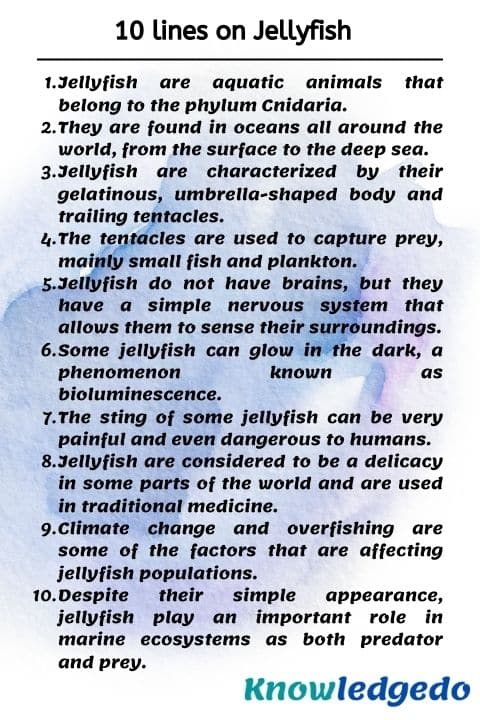Today, we are sharing 10 lines on Jellyfish in English. This article can help students who are looking for information about 10 lines on Jellyfish. This Lines is very simple and easy to remember. The level of these Lines is moderate so any student can write on this topic.
This article is generally useful for class 1,class 2,class 3,class 4,class 5,class 6,class 7,class 8,class 9,class 10,class 11,class 12
10 lines on Jellyfish
1) Jellyfish are aquatic animals that belong to the phylum Cnidaria.
2) They are found in oceans all around the world, from the surface to the deep sea.
3) Jellyfish are characterized by their gelatinous, umbrella-shaped body and trailing tentacles.
4) The tentacles are used to capture prey, mainly small fish and plankton.
5) Jellyfish do not have brains, but they have a simple nervous system that allows them to sense their surroundings.
6) Some jellyfish can glow in the dark, a phenomenon known as bioluminescence.
7) The sting of some jellyfish can be very painful and even dangerous to humans.
8) Jellyfish are considered to be a delicacy in some parts of the world and are used in traditional medicine.
9) Climate change and overfishing are some of the factors that are affecting jellyfish populations.
10) Despite their simple appearance, jellyfish play an important role in marine ecosystems as both predator and prey.

5 lines on Jellyfish
1) Jellyfish are soft-bodied, free-swimming aquatic animals.
2) They have a simple body structure with a bell-shaped body and tentacles.
3) Jellyfish can range in size from as small as a few millimetres to as large as several meters in diameter.
4) They are found in all the world’s oceans, from the surface to the depths.
5) Jellyfish are an important food source for many marine animals and are also used in various human industries such as medicine and cosmetics.
FAQ
Answer: Not all jellyfish are dangerous to humans. However, some species of jellyfish have a potent sting that can cause pain, swelling, and even death in some cases. It’s important to be aware of the jellyfish species in your area and take necessary precautions when swimming or diving.
Answer: Jellyfish have a complex life cycle that involves both sexual and asexual reproduction. In sexual reproduction, males release sperm into the water, which fertilizes the eggs released by the female. In asexual reproduction, the jellyfish can produce clones of themselves through a process called budding, where new individuals develop from a parent body.
Answer: Jellyfish play an important role in marine ecosystems as both predator and prey. They are a food source for many marine animals, including fish, turtles, and birds. At the same time, they also feed on zooplankton and small fish, helping to control their populations. Some species of jellyfish have been known to cause disruptions to ecosystems when they undergo population booms, as they can outcompete other species for resources.
